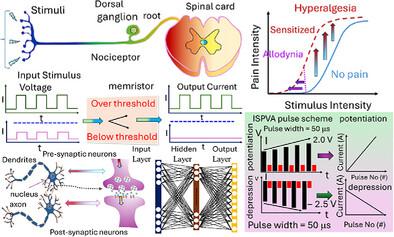Hybrid WS2-Based Memristor With Tunable Conductance Modulation for Neuromorphic and Nociceptive Learning
IF 12.1
2区 材料科学
Q1 CHEMISTRY, MULTIDISCIPLINARY
引用次数: 0
Abstract
Here, a high-performance memristive device that integrates a layered WS2 switching medium with a TiOx-rich interface and a BaTiO3 (BTO) dielectric layer is reported. This hybrid structure exploits the defect tunability of WS2 to regulate oxygen vacancy dynamics, while BaTiO3 enhances electric-field stabilization and TiOx acts as a redox-controlling barrier. The device exhibits analog multilevel switching at low voltages (±0.5 V), a wide memory window (>10), stable retention beyond 10⁴ s, pulse endurance exceeding 10⁵ cycles, and ultralow switching energy (≈54.7 pJ per event). Uniform switching is achieved, with cycle-to-cycle variation of 3.6% and 2.3% for Set and Reset states, respectively. Discrete 5-bit (32-level) resistance states are realized under DC sweeps, enabling high-density memory storage. A broad range of synaptic plasticity features such as long-term potentiation (LTP), long-term depression (LTD), paired-pulse facilitation (PPF), post-tetanic potentiation (PTP), spike-number-dependent plasticity (SADP) and spike-amplitude-dependent plasticity (SADP) - are successfully reproduced. Furthermore, the incremental step pulse with verify algorithm (ISPVA) algorithm enables precise 4–6-bit conductance modulation with enhances linearity, symmetry, and suppress variability. The device also mimicked nociceptor-like behaviors including no adaptation, allodynia, and hyperalgesia. When integrated into an artificial neural network (ANN)ANN, the device achieves a recognition accuracy of 97.4% on the MNIST dataset. These results establish the WS2-based hybrid memristor as a strong candidate for energy-efficient neuromorphic and adaptive sensory applications.

基于ws2的可调电导混合记忆电阻器用于神经形态和伤害性学习
本文报道了一种高性能忆阻器件,该器件集成了具有富tiox界面的层状WS2开关介质和BaTiO3 (BTO)介电层。这种杂化结构利用WS2的缺陷可调性来调节氧空位动力学,BaTiO3增强电场稳定性,TiOx作为氧化还原控制屏障。该器件具有低电压(±0.5 V)下的模拟多电平开关、宽记忆窗(>10)、超过10⁴的稳定保持、超过10个5周期的脉冲耐久、以及超低的开关能量(每事件≈54.7 pJ)。实现了均匀切换,Set和Reset状态的周期间变化分别为3.6%和2.3%。离散的5位(32级)电阻状态在直流扫描下实现,使高密度内存存储成为可能。广泛的突触可塑性特征,如长时程增强(LTP)、长时程抑制(LTD)、成对脉冲促进(PPF)、强电后增强(PTP)、spike-number-dependent plasticity (SADP)和spike-amplitude-dependent plasticity (SADP) -被成功复制。此外,增量步进脉冲验证算法(ISPVA)算法实现了精确的4 - 6位电导调制,增强了线性,对称性和抑制可变性。该装置还模拟了类似伤害感受器的行为,包括不适应、异常性疼痛和痛觉过敏。与人工神经网络(ANN)集成后,该设备在MNIST数据集上的识别准确率达到97.4%。这些结果表明,基于ws2的混合忆阻器是高效节能的神经形态和自适应传感应用的有力候选者。
本文章由计算机程序翻译,如有差异,请以英文原文为准。
求助全文
约1分钟内获得全文
求助全文
来源期刊

Small
工程技术-材料科学:综合
CiteScore
17.70
自引率
3.80%
发文量
1830
审稿时长
2.1 months
期刊介绍:
Small serves as an exceptional platform for both experimental and theoretical studies in fundamental and applied interdisciplinary research at the nano- and microscale. The journal offers a compelling mix of peer-reviewed Research Articles, Reviews, Perspectives, and Comments.
With a remarkable 2022 Journal Impact Factor of 13.3 (Journal Citation Reports from Clarivate Analytics, 2023), Small remains among the top multidisciplinary journals, covering a wide range of topics at the interface of materials science, chemistry, physics, engineering, medicine, and biology.
Small's readership includes biochemists, biologists, biomedical scientists, chemists, engineers, information technologists, materials scientists, physicists, and theoreticians alike.
 求助内容:
求助内容: 应助结果提醒方式:
应助结果提醒方式:


